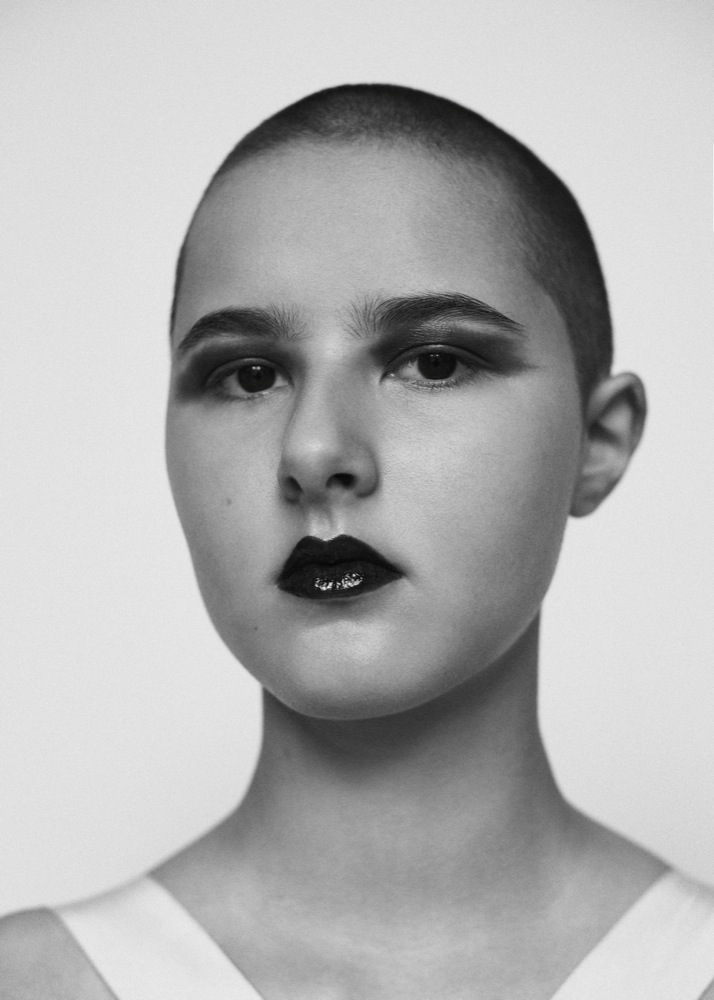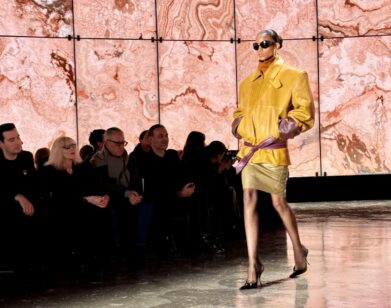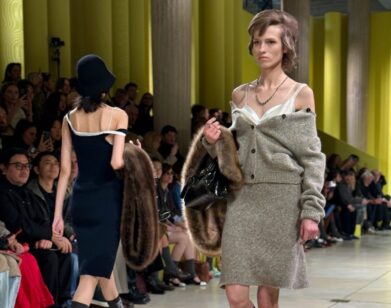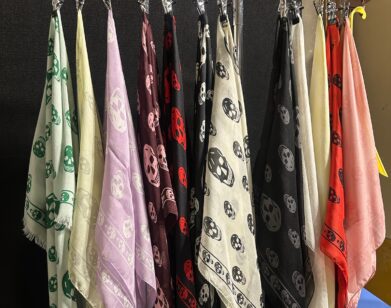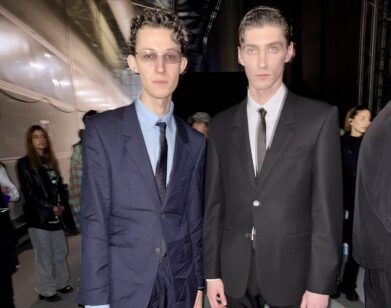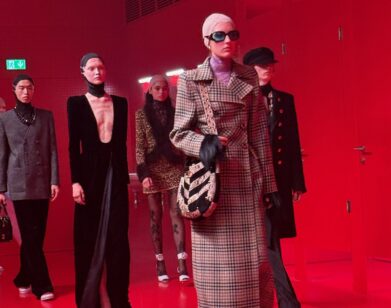Discovery: Conner Ives
PHOTOS: MARK RABADAN. STYLING: NATALIE BREWSTER. HAIR: MAKI TANAKA USING BUMBLE AND BUMBLE. MAKEUP: EMMA WILLIAMS USING MAC PRO COSMETICS. MODEL: TABBY/IMG MODELS. CASTING: DAVID CHEN. STYLING ASSISTANT: ALESSIA SIMPSON.
At only 21 years old, Conner Ives already boasts an impressive résumé. In the last few months, the aspiring fashion designer has taken on projects usually reserved for more seasoned artists, creating styles worn by Rihanna, Edie Campbell (photographed by Tim Walker for i-D), and Adwoa Aboah, including his dream gig: dressing Aboah for the 2017 Met Gala.
From the back-roads of Bedford Hills, New York, Ives travelled across the pond in 2014 to attend Central Saint Martins in London. After his foundation year, he took a year off to work on his portfolio. In 2016 he began his BA in fashion. Though based in the U.K., Ives considers his work distinctly American. His creations are the fortuitous result of vintage items reimagined by Ives’s careful eye.
His pieces often incorporate sequins and fringe. “It is just so wholeheartedly me and I’m so lucky that I get to extend myself in this way,” Ives tells us. “I feel really so deeply connected to all of the things that I produce.” From edgy, collaged T-shirt dresses to delicate, floral slips, Ives converts the familiar into something new. His playful designs stretch the boundaries of how we imagine everything from stockings to scarves.
Ives’s enthusiasm is palpable; he envisions his looks from top to bottom, even designing jewelry and shoes when the occasion calls for it. “I think ‘fashion designer’ is really a great title because it’s not just clothes—the best fashion designers kind of do everything,” he says. “They’re stylists. They’re creative directors. They can manage casting.”
When we speak via phone, Ives is already gearing up for his next project: “I have to make a lot of things tonight that don’t exist yet,” he says, laughing. Luckily, Ives is no stranger to sleepless nights, thriving on creative energy and dedication to his craft.
AGE: 21
HOMETOWN: Bedford Hills, NY
BASED IN: London, England
A CALLING: I get really consumed by things. I describe it to people without trying to sound too dramatic, [but] I don’t know what I would do if I couldn’t do this. It feels necessary. It feels quite natural. I’d definitely need a job like this: a non-job. Fashion designer doesn’t feel like a job to me—it feels like I get to play and stay up at all hours. I’d obviously do something in art. I don’t think I’d last a day in an office.
EARLY DAYS: Even as kids, my sister and I would make things like finger puppets; we would dress up our fingers in outfits. It went from fingers and then I made clothes for my stuffed animals periodically throughout childhood and eventually just progressed into people.
THE BIG MOVE: When I got to [Central Saint Martins], I was 18 years old. I had just graduated from American public high school. I really had little to no experience in an arts education kind of setting. I didn’t really know what I signed up for. I thought I was starting my bachelors, but in the U.K., before you do a bachelor’s, you have to do what’s called an “arts foundation.” I ultimately got to CSM and started in the fashion textiles foundation there, which is a notoriously difficult process to get through.
A ROCKY BEGINNING: The places that [CSM] gives out are quite selective. You’re brand new to a foreign country, you’ve just sort of made all these lovely friends, and then you’re told that you’re all competing for X amount of spots and you have this amount of time and, “Go!”
[That first year] was quite difficult and quite testing. I think ultimately I couldn’t get out of my head enough—I couldn’t stand behind the work anymore and I had no idea what I was doing. I really am not the kind of person to be like that, but even when they were asking me about the work, after a while I had no idea what to say. I would just stare blankly at them because I had no idea.
I went through a lot. It was not a straight shot. There were a lot of bumps and stops along the way. Ultimately in those moments, you never think that this is going to happen to you, but looking at it from this perspective, you see all those hardships and you realize how much stronger they made you, how much more I could stand behind my word and my work and because they really make you question that.
ENVIRONMENTALLY CONSCIOUS DESIGN: When I was 16 or 17, I had this bizarre realization of the amount of waste that goes into [fashion]. I was so dissatisfied by it and almost depressed because I loved design so much. I couldn’t imagine that something that was so positive and so good to me could create something this horrible. The amount of waste and pollution that we’re putting out just by making crazy amounts of clothing is so sickening to me. My use of recycling is a really natural reaction to that dissatisfaction and wanting to change it.
There are so many clothes that I just thought, “Why create something new when there are things that have been used and loved and worn? Why don’t they deserve a new life?” So that’s kind of what I do, or what I like to think I’m doing.
People will be like, “Oh, where do you find the stuff?” I’ll find it in the same stores that people go vintage shopping in. It’s not like I have secret sources that have these magical things for me—well, maybe I have a few people like that, but I can’t reveal all of my sources right now. [laughs]
It’s one of these serendipitous things where ultimately all of these things just fall into place and then I have a purple sequin top that matches this purple feather that I found here. It’s quite fun to do because it feels really magical a lot of the time. You’ve just got to keep your eyes open. It’s all out there.
SAMPLING MATERIAL: What I do is such a celebration of the objects and the things that I use that if a person was really upset that I had taken something or was using something that was theirs, I would give them full credit. So much of what I do is collaborative and not just me, I would obviously want to give them that and to share that with them.
PATRIOTISM & POLITICS: The title of [my most recent collection] is “Take My Hand Precious Lord,” which is an Elvis song and an Aretha Franklin song, but it’s originally a gospel song. It was hymn used a lot in gospel church and Baptist churches as almost a means for surrender.
I don’t think my work has ever been innately political before, but it’s always been American. In the year 2017 in America, to not be political is un-American. This [collection] was my response to a lot of the frustration and things that I had on my mind just watching the last year of events unfold outside of America and looking in. I didn’t want it to be dark or depressing or anything. I almost wanted to celebrate the aspects of America that I remembered fondly in my head. A lot of the pieces are different, very personal references for me. The Patagonias are painted with folk paintings that I painted myself, but are based actually on my favorite American folk paintings. [It’s] an exploration of the parts of America that I could think of still as beautiful.
MUSES & MODELS: My parents are definitely huge inspirations to me. My friends. There are obviously designers I look up to as well, but when you’re in this setting, you realize that a lot of your friends are becoming designers, big designers. It’s been so amazing to me to watch people reach these huge pinnacles in their careers and be so driven and inspiring.
[The models I use] are always my friends. So many of the people around me are so beautiful and so inspiring and so talented. Every single girl who has modeled for me has really honestly had huge say in the creative process. We’ll be doing fittings and I’ll be trying things on them and I’ll be like, “What do you like? What do you want to wear?” Asking them how things feel, how things fit, because that’s such an intrinsic part of what I do. I’m not a woman, but I’m trying to convey the best possible message to and for a woman. I don’t think you can do that without a lot of girlfriends. [laughs]
THE T-SHIRT DRESS: I have this loving relationship with T-shirts and I always have. I have these two or three T-shirts that were my dads before they were mine, and then I stole them when I was, like, 15 and I have ultimately had them since then. That was something where it was such an object that I coveted or could look at and say, “Oh, this is a good T-shirt,” or, “This is a bad T-shirt.” I realized a good T-shirt or two good T-shirts would make an amazing dress, and that realization was so natural.
THE DESIGN PROCESS: I think I made that first T-shirt dress in two hours. It was something that just happened. It’s something that I find happening a lot in my work and I’m so blessed that I have that ability. That is the design process for me. [laughs] It’s so terrible for me to explain because I say to people, “Well, I just do it,” and it sounds like such a cop out, but I really do just do it. I couldn’t elaborate much more on it.
YOUNG SUCCESS: It’s weird to find yourself in these moments—you have to disassociate yourself from the actual moment of it because you need to keep your head clear. If I were to have a full reaction to these things every time that they happen, I would have a heart attack because it’s just the way that I am. I get chills every time it’s brought up [laughs]. It’s really nice to get the recognition and it feels very, very humbling. Getting introduced as a designer is so crazy to me because I’m like, “I’m a student [laughs].” I’m floored by it all.
WHAT’S NEXT: Now it’s just a matter of finishing school. It’s something that I’ve had my heart set on since I was 12 years old: going to Saint Martins, doing womenswear, graduating from the program. That would be one of the biggest honors I could think of in the next few years.
FOR MORE ON CONNER IVES, VISIT HIS WEBSITE.

